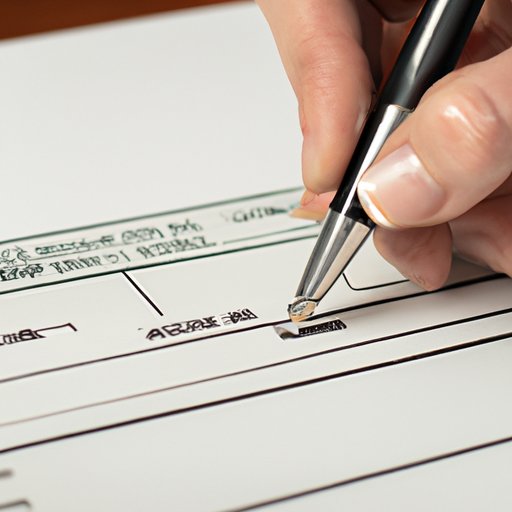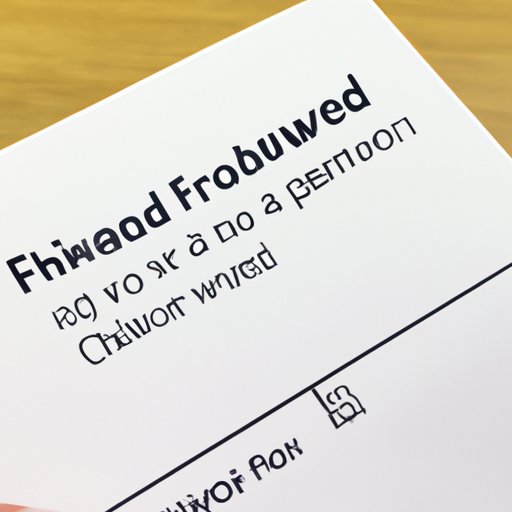
Introduction
Money is an integral part of our lives, and financial transactions are a regular occurrence. When it comes to checks, we often encounter situations where we need to sign them over to someone else. This article aims to guide you through the process of signing a check over to someone else. By the end of this article, you will have a comprehensive understanding of the different methods of check endorsement and transferring checks to others.
Handing Over the Power: A Guide to Signing a Check Over to Someone Else
Firstly, it’s important to understand that check endorsement is the act of placing a signature on the back of a check. The purpose of endorsement is to transfer the right to cash or deposit the check from one person to another. Once a check is endorsed, it becomes negotiable, meaning that it can be cashed or deposited by someone other than the person named on the front of the check.
There are a few reasons why you might want to sign a check over to someone else. For example, you might receive a check made out to you as a gift, but you would like to use the funds to pay for something for someone else. Alternatively, you might receive a check as payment for a service but want to give a portion of the money to someone else that helped you with the service. Whatever the reason, there are risks and precautions that you need to be aware of.
From Endorsement to Transfer: A Step-by-Step Tutorial on Signing a Check to Someone Else
Let’s take a closer look at the step-by-step process of signing a check over to someone else.
Step 1: Verify that the check is eligible for endorsement
Before signing over a check, you need to confirm that the check is eligible for endorsement. If the check has already been endorsed by the beneficiary, then it is not eligible for further endorsement.
Step 2: Endorse the check correctly
To endorse a check, you need to sign it on the back. Typically, you would sign your name on the top line. If you are signing the check over to someone else, you will also need to write “Pay to the order of [person’s name]” on the next line. By writing this, you are indicating that you are transferring the rights to the person you mentioned.
Step 3: Add a restrictive endorsement if necessary
When signing a check over to someone else, it is also a good idea to add a restrictive endorsement. A restrictive endorsement limits the use of the check and provides additional security. For example, you could write “For deposit only to account number [account number]” on the third line. This restrictive endorsement ensures that the check can only be deposited into the specific account mentioned.
Step 4: Provide a written direction to the bank
It is essential to provide a written instruction to the bank when signing a check over to someone else. The written direction should mention that you are transferring ownership of the check. You could write a simple statement like “I hereby transfer the ownership of this check to [person’s name].”
Step 5: Document the transaction
Lastly, it is crucial to document the transaction by keeping a record of it. Date the check and make a copy of the front and back of the check for your records.
Sharing the Wealth: How to Properly Sign a Check Over to Another Person
There are three different methods of signing a check over to someone else: blank endorsement, special endorsement, and restrictive endorsement.
A blank endorsement is where you simply sign the back of the check and hand it over to the person you are giving it to. This method is the riskiest as it doesn’t specify who the check is intended for or what the funds should be used for.
A special endorsement is where you sign the back of the check, but instead of just writing the name of the person you are giving it to, you also write “Pay to the order of [person’s name].” This method is slightly more secure than a blank endorsement as it ensures that the check is intended for the person you mentioned.
A restrictive endorsement limits the use of the check, as mentioned earlier.
The method you choose depends on your specific situation, but it’s important to choose the method that conforms to your bank’s policies. Some banks might not allow certain types of endorsement, and it’s best to check with your bank before endorsing the check.
The Etiquette of Endorsing a Check to Someone Else: A Complete Guide
When it comes to signing a check over to someone else, it’s important to know who should sign the check over. Generally, the person who receives the check should sign it over, unless they are unable to do so.
If you need someone to sign a check over to you, it’s essential to ask them politely. Explain why you need the check and what you intend to use it for. Always ask before making any assumptions.
Avoid making common mistakes when endorsing a check. For example, it’s essential to endorse the check using the exact name that the check is made out to. It’s also crucial to ensure that the signature is consistent with your signature on file with the bank.
Endorsement Made Easy: 7 Simple Steps to Sign a Check Over to Someone Else
Here is a simplified version of the step-by-step tutorial:
1. Verify that the check is eligible for endorsement
2. Endorse the check correctly
3. Add a restrictive endorsement if necessary
4. Provide a written direction to the bank
5. Document the transaction
6. Choose the appropriate method according to bank policy
7. Follow proper etiquette and avoid common mistakes
A Complete Guide to Signing Over Checks to Help a Loved One
There are some specific considerations to keep in mind when signing a check over to a loved one. When you sign a check over to someone else, you are transferring ownership of the funds. As such, the person that the check is signed over to is legally entitled to the funds. This means that it’s crucial to trust the person you are signing the check over to.
It’s also important to note that signing a check over to someone else can have legal and financial implications. For example, depending on the amount involved, the transaction could incur gift taxes. If the check is for a large sum of money that could impact the beneficiary’s eligibility for government programs like Medicaid or Supplemental Security Income, it could lead to reductions in benefits.
It’s important to speak to a professional, such as an accountant or lawyer, if you are unsure about the consequences of signing a check over to a loved one.

Paying It Forward: How to Endorse a Check to Help Someone Else
In some circumstances, you might want to use endorsed checks to help others, like donating to a charity or gifting someone.
If you plan to donate money through endorsed checks, it’s vital to ensure that the organization you are donating to accepts such types of donations. You might also want to add a note to the check indicating the cause you would like to support.
To gift money to someone, it is essential to communicate with them beforehand and ask for their preferred method of endorsement.
Conclusion
In summary, there are many different reasons why someone might want to sign a check over to someone else. Whatever the reason, it’s essential to follow the proper procedures to ensure a smooth transaction that protects both parties. Always remember to document the transaction and seek professional advice if unsure about any legal or financial implications.
With this guide, you should now have a comprehensive understanding of how to sign a check over to someone.




